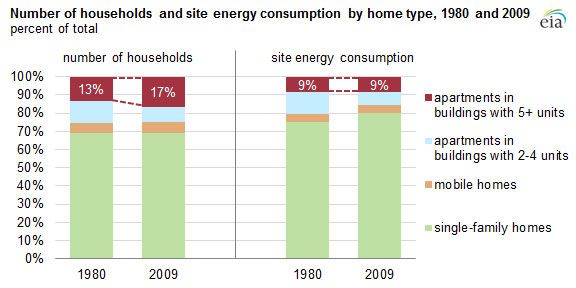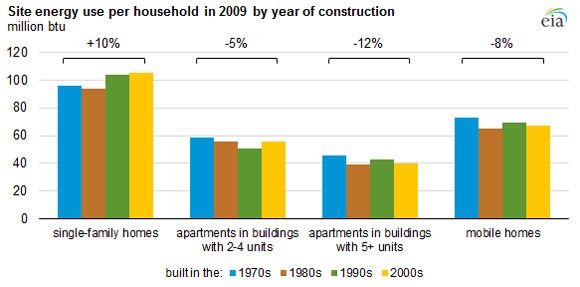If you live in an apartment building with five or more units, you probably use significantly less energy than your friends living in single-family homes.
Maybe you have suspected this, because your apartment is so much tinier than most people’s houses (which is certainly the case for this reporter) and therefore uses less energy. Or perhaps you already pat yourself on the back regularly for being an urbanite who lives efficiently, from taking public transportation and using bike shares to unplugging electronics and community composting.
But something else is also going on. Sure, the average home uses more energy than an apartment because of size. Also, apartments generally have fewer windows and outside walls.
But many apartment dwellers rent instead of own, and therefore they should fall into the split incentive problem where the owner is not incentivized to make energy-efficient upgrades because the tenant pays the electricity bill. However, it appears that the split incentive issue has not prevented significant gains from happening.

Even without substantial energy efficiency upgrades in multifamily buildings, the per-household energy use in larger apartment buildings has fallen 38 percent since 1980, according to the U.S. Energy Information Administration. The change in energy for heating is even more significant for this housing class, with a drop of nearly 50 percent.
Other home types have also seen decreases, mostly from efficiency improvements in major appliances, but larger houses offset the gains, so it’s essentially a slight increase for single-family homes over the years. But the graph above shows why the bulk of home energy management companies focus on single-family homes and not multifamily units. Single-family still makes up the bulk of housing stock in the U.S. -- and clearly that's where the most gains in efficiency can be made in a single home.

Some companies, such as WegoWise, are addressing the energy needs of multifamily units. Because of the split incentive issue, multifamily is not quite the same beast as single-family properties and has to be approached differently. But for those that can crack the nut, it could be a $3.4 billion energy efficiency opportunity, according to the American Council for an Energy-Efficient Economy.
Successful solutions could be the ones that target the pain points of some of the largest urban areas with the oldest -- and least efficient -- housing stock. ThinkEco, for example, has a solution to control window air-conditioners, which are prevalent in older homes everywhere and in cities such as New York and Philadelphia that have a lot of old buildings. Another problem, which startup Radiator Labs is tackling, is how to cheaply retrofit old steam heaters that give off so much heat that some users are forced to leave their windows open in winter.
There will be many winners and losers in home energy management in coming years, but tailored solutions for the increasing number of apartment dwellers are a niche only a few have tackled. Thirty percent of new homes in 2012 were multifamily buildings with more than five units, the highest rate since 1986. The offerings may also have to be regional, as seven of the most densely populated urban areas are in California, and the fastest-growing cities are in the South.



